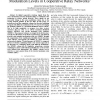Free Online Productivity Tools
i2Speak
i2Symbol
i2OCR
iTex2Img
iWeb2Print
iWeb2Shot
i2Type
iPdf2Split
iPdf2Merge
i2Bopomofo
i2Arabic
i2Style
i2Image
i2PDF
iLatex2Rtf
Sci2ools
VTC
2008
IEEE
2008
IEEE
Diversity Combining of Signals with Different Modulation Levels in Cooperative Relay Networks
In digital cooperative relaying, signals from the source-destination and relay-destination links are combined at the destination to achieve spatial diversity. These signals do not necessarily belong to the same modulation scheme due to the varying channel qualities of the two links. In this paper, we present novel and low complexity schemes for diversity combining of signals with different modulation levels. We start by developing the optimum solution as a maximum likelihood detector (MLD). Due to its high complexity, we propose two other receiver structures that we refer to as soft-bit maximum likelihood detector (SBMLD) and soft-bit maximum ratio combiner (SBMRC). The proposed schemes are simple bit-by-bit detectors and only 0.3 dB inferior to the MLD in performance. The SBMLD provides only marginal performance gain over SBMRC through the computation of the conditional probability density functions of the soft-bits. Consequently, the SBMRC is a more attractive and practical solution....
Communications | Maximum Likelihood Detector | Maximum Ratio Combiner | Soft-bit Maximum | VTC 2008 |
| Added | 01 Jun 2010 |
| Updated | 01 Jun 2010 |
| Type | Conference |
| Year | 2008 |
| Where | VTC |
| Authors | Akram Bin Sediq, Halim Yanikomeroglu |
Comments (0)

